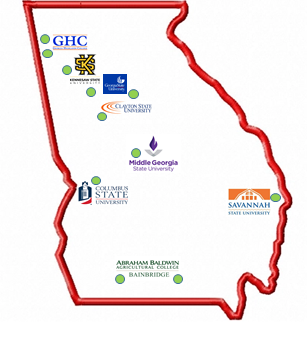University System of Georgia Campus Plan Update 2019
System Overview
The Complete College Georgia initiative is a collaborative effort among Georgia’s K-12 schools, public colleges, universities and technical colleges, and the private sector to take concrete steps to improve college access and completion in the state. Framed on a set of high impact strategies organized around nine goals, the data-driven initiative builds on national research and local activities to support student success at all levels. The overarching goal is to graduate an additional 250,000 Georgia students with high-quality degrees or certificates by 2025 in order to reach projections of employment readiness. Since 2011, each institution in the University System of Georgia and Technical College System of Georgia have submitted and updated action plans on the policies and procedures that they will implement to have the greatest impact on college completion within their institutional mission and context.
For the University System of Georgia, Complete College Georgia (CCG) has evolved into a framework for focusing institutional attention on what matters most: helping Georgia’s students succeed. Institutions have adopted, adapted, and promoted a wide range of strategies to suit their local settings. More importantly, the work of promoting student success has become broadly shared on campus and better understood across the units of institutions. CCG continues to forge partnerships among functional areas and foster understandings of how the various elements of a college or university come together. These partnerships have created statewide support for Georgia’s orientation in building a 21st century workforce.
System Profile
The University System of Georgia (USG) includes 26 institutions, with fall 2018 enrollment of 328,712 students. Academic year 2018 marked the fourth consecutive year that enrollment in the University System has exceeded the recession peak (fall 2011—318,027) and is an increase of 3,509 or roughly 1.1 percent, over fall 2017. The increase in enrollment at USG institutions compares favorably with national trends, with four-year public institutions nationally experiencing a very slight (-0.2 percent) drop in enrollment in the past year.
The University System’s institutions in fall 2018 headcount ranged from 2,187 at Atlanta Metropolitan State College to 52,814 at Georgia State University. Georgia Tech witnessed the greatest percentage increase in enrollment in 2016 at 11.4 percent (largely driven by their online master’s in computer science program), followed by the Middle Georgia State University at 6.3 percent and the University of North Georgia at 5.0 percent. Atlanta Metropolitan State College saw the greatest decline in enrollment since 2017, dropping 12.6 percent, followed by Gordon State College and Savannah State University, which shrank by roughly 8 percent each. Nearly 84.7 percent of students served by USG institutions are from Georgia, with almost 10 percent of students from out of state, and just over 5 percent of enrollment consisting of international students.
The USG serves a diverse population:
» 49.3 percent white » 26.2 percent Black
» 9.5 percent Asian » 9.1 percent Hispanic
» 5.8 percent other categories/unreported
Over the past five years, the number of Hispanic students has increased by 40 percent and the percentage of Asian students has increased by 30 percent. Black or African American enrollment has been relatively flat and white enrollment has declined by 2 percent over this same period. Figure 1 illustrates the shifting composition of students enrolled in USG institutions.
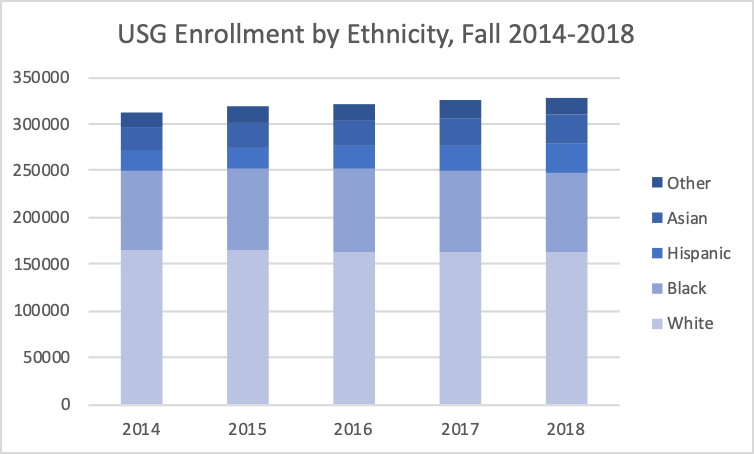
Complete College Georgia launched in 2011 with a commitment to increase the educational attainment of Georgians and a specific goal of increasing the percentage of young adults aged 25-34 with a credential of economic value from 40 percent to 60 percent by 2025. In partnership with the Technical College System of Georgia, private colleges and universities in the state and the state’s K-12 system, Complete College Georgia has begun to narrow the gap between that ambitious goal and the attainment of the young adult population. As of 2018, 50 percent of the young adult population—more than 720,000 Georgians under the age of 36—has earned a credential of economic value (certificate leading to licensure or an associate degree or higher). Undergraduate degree conferrals in the University System have risen by 21 percent since 2011 (from 40,867 to 49,190). The figure below illustrates this trend.
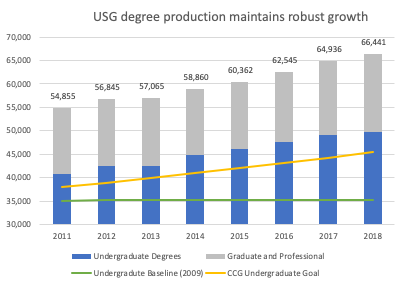
For all this success, however, the state still has a substantial way to go. Significant gaps in attainment, retention, and graduation exist between African Americans and Hispanics and the white population. While African Americans and Hispanic are an increasingly larger share of the younger population in the state, they remain underrepresented in attainment data. There exists a 12 percentage point gap between the share of the population with an associate degree or higher for the African American and the white population aged 25 and over, and a 19 percentage point gap with Hispanics. This gap is echoed in USG graduation rate gaps, with African American six-year graduation rates systemwide lagging 22 percentage points (41.8 percent to 63.8 percent for the 2011 cohort), and Hispanic rates lagging by 9.6 percentage points (54.2 percent to 63.8 percent).
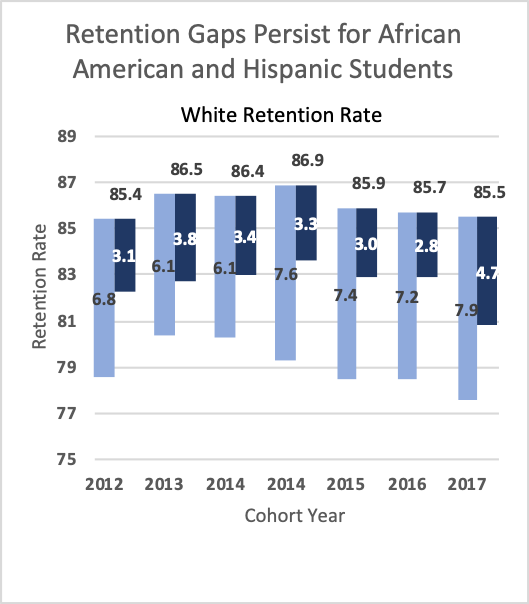
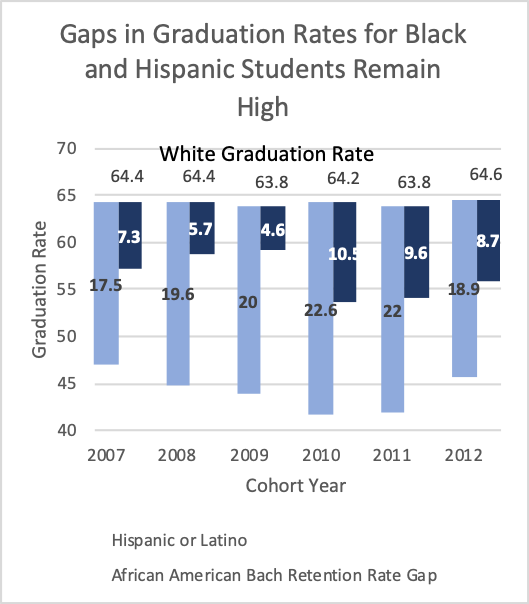
Momentum Year Update
The Momentum Year is a three-part approach to the beginning of a student’s first year designed to improve student success rated and close these gaps. Evidence-based research confirms that college students are most successful when they start out their college careers by making a purposeful choice in a focus area or program of study, enter with a productive academic mindset, and follow clearly sequenced program maps that include core English and math, nine credits in the student’s academic area of interest, and 30 credits. This concept was first introduced at the 2017 Advising Academy and further developed at the Momentum Summit I in February 2018. At these events, institutions began their initial planning for taking a Momentum approach to a student’s first year.
The University System hosted the Momentum Summit II in January 2019, assembling 500 administrators, staff, deans and chairs from across the state to develop Momentum strategies that support the first year and beyond. Institutions heard from peers and worked as teams to refine their established Momentum Plans with a focus on full implementation by the fall. Additionally, through structured experiences, participants explored how they can support all students purpose, ensure transparent paths to graduation, and develop productive academic mindsets across the breadth of the institution and the length of the student’s experience.
During the 2018-2019 academic year institutions across the USG scaled up their implementation activities to support the Momentum Year with the goal of full implementation of the Momentum Year Strategies for all students by fall 2019. This work was supported by the system office through targeted and statewide convenings, support for the development of discrete and comprehensive plans, specific implementation guidance, and ongoing information gathering and process documentation.
Purposeful Choice and the Transition to College
Evidence from the first USG Mindset Survey reinforced research elsewhere of the critical benefit to student success of making connections with students’ purpose. This is the logic that underlies the expectation for asking students to select a program of study or academic focus area at the very start of their academic career.
By connecting students with their purpose, institutions support their transition not just to higher education generally, but build important connections to the institution, discipline, and future that support engagement and success. Building these connections is of benefit to all students, but may be especially important for minority, low-income, rural and first-generation college students. To support this work the System Office has structured planning and training events for advisors, enrollment managers, faculty, and front line staff on framing student choices in ways that have been demonstrated to help support better decision making. Borrowing from research on behavioral economics and scarcity, the System Office has promoted the use of smart defaults for students to minimize choice paralysis, particularly in the selection of programs of study.
Focus Areas
Throughout 2018-2019, institutions worked to align their academic programs into focus areas. Focus areas are essentially groups of degree programs that have first year programs of study that largely overlap. Focus areas support student choice-making in a number of ways. By organizing multiple degree programs into a limited number of groups, focus areas help students avoid choice paralysis, simplify the selection of a first year program of study, and help support advising discussions that allow for an iterative process while supporting progress toward a major without the risk of students accruing credits that “don’t count” toward a final major. Also, focus areas support student exploration within an area, helping students to decide amongst a range of possible disciplines, and to identify “offramps” into related fields that will maximize retained credits and are most likely aligned with a students’ purpose for attending college.
To support institutions in their work to improve the transition to college and support the process of purposeful choice. At the 2018 Advising Academy, 229 administrators, faculty and staff convened to review and reflect upon their processes and procedures for the transition to college. To support this work, the University System Office reviewed national research and statewide practices to develop ten key elements for the transition to college. Using this framework, institutions developed Transition Improvement Plans at the Academy that guided their work for the incoming class of 2019. A key component of these plans was the integration of student and academic affairs functions in the transition programming and an intentional process to help guide students to a purposeful choice during the transition process.
In support of this work, the System Office developed a focus area enhancement for Banner that records students’ focus area choice, providing opportunities at institutions for targeted advising, communications, and programming for students exploring programs in a focus area. Furthermore, System Office Staff conducted field observations of transition programs across the state to develop a fuller understanding of current practices and needs.
Clear Pathways
As an outcome of the Momentum Summit II, institutions were asked to “pressure test” their programs of study using a methodology established at the event. Pressure testing involves assessing whether students can reasonably be expected to follow an established program path to on-time graduation using the courses as they are currently scheduled. This involves both an audit of the existing curricular requirements for “hidden” prerequisites and course sequences and a review of advising supports, program maps and course availability and rotations to determine whether students can discover, and enroll, in courses that are required for their degree at the time when they are needed. Institutions completing their audits reported their results to the System Office, and the outcomes resulted in advising, program map, and course availability changes for the upcoming year to support progression.
Across the USG, all 26 institutions provide curricular maps for each academic program that outline the courses students should take in a term-by-term fashion to ensure on-time graduation, up from 21 in 2017. Two institutions have substantial commitments to academic advising processes that create personalized plans for each student as opposed to program default maps.
CoRequisite Learning Support
A significant accomplishment for the System in the past year is the full scaling of CoRequisite Learning Support for all students. After four years of mounting evidence of the success of students across all levels of preparation in collegiate-level math and English when accompanied by simultaneous, mandatory academic support, the System shifted policy to eliminate stand-alone prerequisite remediation in Fall 2018. The first year at full scale was accompanied by shifts in placement into different math courses, with students requiring Learning Support in Quantitative Reasoning and Math Modeling ineligible to pursue College Algebra directly.
Because more less prepared students were expected to be directly enrolling in collegiate-level courses after the move to fully-scaled CoRequisite Learning Support, it was anticipated that there would be reductions in the overall pass rate for learning support students in comparison the partial implementation. Interestingly, evidence from the first year of implementation for all students indicates that across almost all levels of preparation, success rates for students have improved slightly. That this is the case reflects the concerted effort that institutions across the state have made to develop aligned and appropriate support courses for students, work that was catalyzed through one statewide and two CoRequisite Academies coordinated by the System Office.
As the chart below shows Co-requisite Learning Support, now fully implemented, a has more than doubled the success rates of less well prepared students in math, and almost doubled the similar success are in English.

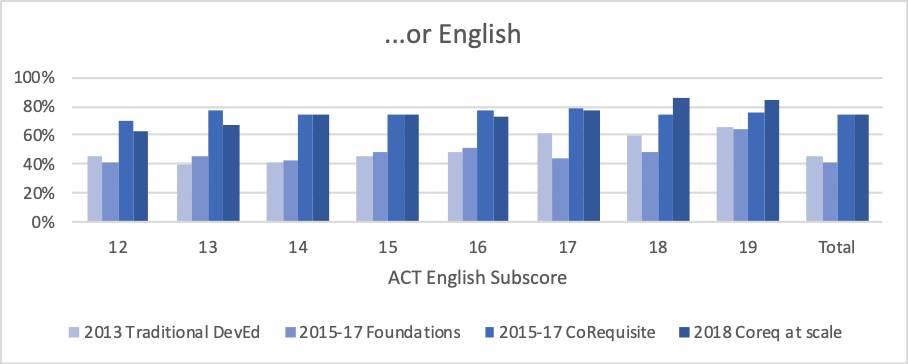
Simultaneously, several institutions engaged in changes to their registration practices for incoming freshmen to encourage fuller schedules, including: more explicit discussions of the connection between on-time credit levels (15 credits a term; 30 credits a year) and on-time graduation and academic success; structured/block schedules for students that either default to 15 credits in their first term or establish protocols to support registration for on-time course loads. These strategies have begun to show signs of success: the percentage of first-time freshmen who are taking 15 or more credits in the fall term increased for the fourth straight year, and the proportion of these students who had earned 30 or more credits in their first year rose significantly after a long period of stagnation. Importantly, much of the institutional work on credit intensity was developed in the 2018-19 academic year, including changes to default schedules for First-time Freshmen that either provided 15 credits in a block or established a structure by which students are directed to select 15 credit course schedules as they begin their academic career. It is anticipated that the incoming freshmen class for the fall 2019-20 academic year will experience substantial increases in both measures.
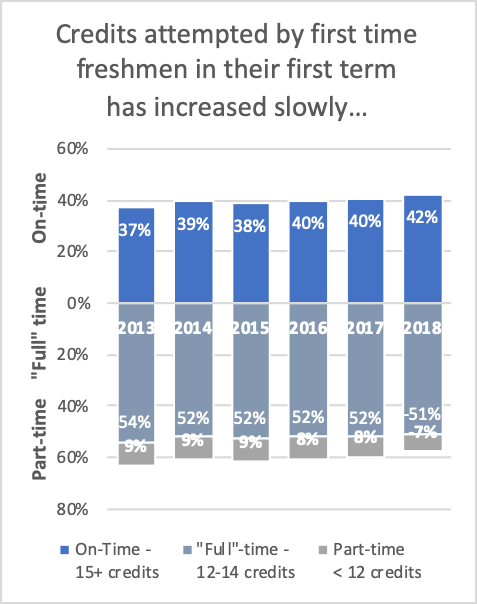
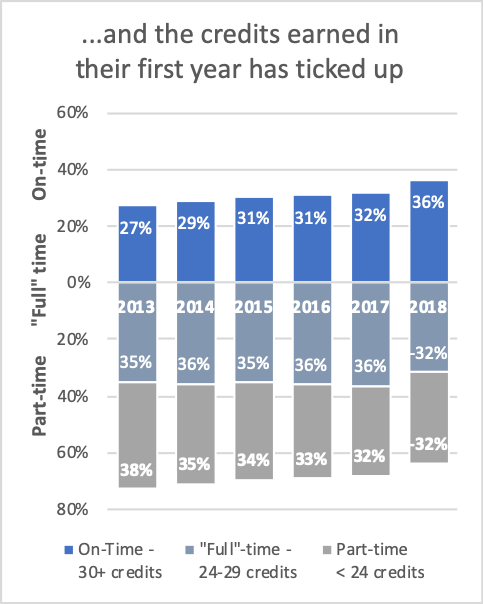
Academic Mindset
Productive Academic Mindset
Academic mindsets—individual’s beliefs about learning that shape how they interpret difficulty—are crucial for success in college. Mindsets can be categorized into three groups of beliefs: growth mindset (the belief that one can improve through effort), purpose (the belief that an activity has value), and social belonging (the belief that one fits in with peers, colleagues, and teachers). Even within the first semester of college, students receive numerous messages from students, instructors, and the institution that shape perceptions of whether they belong in college and have the potential to succeed. Those perceptions, in turn, can affect students’ performance in their classes and decisions to remain enrolled. Research suggests that learning mindsets are malleable and learning mindset interventions are effective at reducing equity and opportunity gaps for students from traditionally underrepresented groups.
To better understand the current scope of learning mindsets for students in the University System and to understand how they affect student outcomes, the System joined with the University of Virginia’s Motivate Lab in creating an Academic Mindset Survey, a 80+ element device administered to all first-time freshmen before their third week of classes and again within the last three weeks of classes. The 2018 survey yielded more than 14,700 discrete responses, providing a snapshot of how students approach their academic work, social integration, and sense of purpose, as well as indicators of scarcity and other factors. Because the survey is linked to student outcomes data, the survey allows the University System an opportunity to explore at a level of detail unmatched elsewhere the impact of academic mindset on student outcomes. The substantial response rate provides one of the largest, if not the largest, data sets on mindset in higher education anywhere.
Also in 2018, the University System hosted its second Mindset Summit for faculty and staff to learn about three academic mindsets and to engage in the research around this area and explore more deeply ways to integrate Mindset work on their campuses and in their classrooms. Additionally, beginning in the Spring term, students in College Algebra in eCore participated in a random-controlled trial of a growth mindset intervention to assess the benefits and potential for scaling this intervention in other online and in traditional courses. Early results seem to indicate that the intervention has a positive impact on both student mindset and grade outcomes, with particularly positive results for First Generation African American students. More complete analysis with a larger sample size is planned for 2019.
Other Institutional High-Impact Strategies, Activities & Outcomes
Educational Innovation
High Impact Practices
The University System of Georgia’s (USG) participation in the NASH TS3 Equity High Impact Practices (HIPs) initiative has resulted in a system wide commitment to include HIPs as an essential component of USG’s Momentum Approach. In order to achieve that objective, USG is creating the following tools and mechanisms to assist institutions with the development, implementation, scale and continuous improvement of HIPs on their campuses.
The incorporation of HIPs into the Momentum Approach to Teaching Student Success Pedagogies will enable USG to leverage its Chancellor’s Learning Scholars initiative to develop learning communities led by faculty who will develop and deliver professional development to other faculty on the design, delivery and evaluation of HIPs on their campuses.
The HIPs Taxonomy for Equitable Learning Pathways is a tool for faculty, teaching staff and institutional leaders to assess their institutional commitment and capacity to implement and scale HIPs.
The integration of HIPs course attributes in Banner will result in a process for identifying HIPs on campuses and tracking their impact on critical student outcome measures.
Six Vanguard institutions are leading the development of this work (Georgia College and State University, Georgia Gwinnett College, Georgia State University, Savannah State University, University of Georgia, and University of West Georgia). To assist in the process of assessing institutional commitments to HIPs, USG worked with institutional leaders in 2018 on the design and deployment of a HIPs Taxonomy for Equitable Learning Pathways. The Taxonomy enables teams from across a campus to assess the presence and scope of implementation of HIPs across campus. These taxonomies are available in draft form to the 26 USG Institutions.
The USG is working with campuses on evaluation criteria for identifying HIPs and then developing attributes of HIPs that can be tracked in USG’s student information system. Entering HIPs attributes into Banner enables the system and institutions to evaluate the impact of HIPs on the critical metrics associated with student momentum and student success. To ensure that all students have success to HIPs, campuses must engage in processes to develop and scale HIPs across campus. The combination of including HIPs in institutional Momentum Plans, utilizing the HIPs Taxonomy for Equitable Learning Pathways and integrating HIPs attributes in the Banner student information system creates the structural tools that institutions need to scale HIPs campus wide. These tools create the institutional commitment to HIPs.
Chancellors Learning Scholars
The Chancellor’s Learning Scholars (CLS) program was designed with a threefold mission: 1) to facilitate pedagogical conversations that lead to course enrichment and improved student learning; 2) to develop a network of strong relationships and enhance collegiality among faculty; and 3) to promote leadership development in USG faculty and the CTL directors.
All twenty-six institutions were invited to submit four nominations to be a Chancellor’s Learning Scholar (CLS). These CLSs would be facilitators of Faculty Learning Communities (FLCs) on their campuses, focusing on one or more of the following topics: course design, small teaching, inclusive pedagogies, and academic mindset.
In September 2018, twenty center directors (or their representatives) met to collaboratively design and develop four pedagogical workshops to support the four FLC topics. They facilitated these workshops for the CLSs at one of two day-long CLS Kick-off Events in October 2018. These workshops became resources that all of the centers took back to to their institutions to use in their entirety. The second goal was to develop a network of strong relationships and enhance collegiality among faculty, which has been fostered through the creation of a network of engaged faculty who have developed connections across their institutions and a structure for discussion the pedagogical innovation and excellence. Survey results of FLC participants indicates an overwhelming majority felt that their participation in the CLS program had a strong or very strong impact on their teaching.
Gateways to Completion (G2C)
Gateway courses are classes that are high-risk with high enrollment and are often the foundation level courses for an academic major. Success in foundation level courses, such as: accounting, biology, chemistry, math, writing and rhetoric, is a direct predictor of retention. Gateways to Completion (G2C) provides faculty and institutions with processes, guidance and tools to support redesign of lower division and/or developmental level courses.
G2C also includes a Teaching and Learning Academy and an Analytics Process Collaborative. University System of Georgia (USG) Faculty attend the Gateway Course Experience Conference and participate in the G2C Community of Practice meetings. There faculty/administrators network with like-minded institutions and reflect on and shape the body of scholarship on gateway course success. The G2C approach provides faculty with a structured, evidence-based course self-study process coupled with guidance and support from the John N. Gardner Institute to redesign critical Gateway courses to deepen learning and improve outcomes. Generally, institutions select at least four high enrollment, high D-F-W rate courses to review and redesign.
The University System of Georgia is the only University System in the nation approaching this work from a System perspective. Cohort I began the three-year process in 2015. The remaining institutions who comprise Cohort II began their work in the 2017-2018 academic year through support from the System Office. Based on the importance of success in core English and Math, institutions in cohort II were required to redesign these courses as a part of their Momentum Year efforts. As well as English and math, Cohort II schools used system-created data-analysis to select two other “catapult” courses whose redesign would have maximal impact on overall student success. In addition to guided work on campus, the G2C project convenes institutions throughout the year to reflect on their work as a community and to shape improvements in their processes.
Cohort 1 completed its initial 3-year cycle officially on June 30, 2019. The initial results from the 10 institutions that comprised the first cohort in Georgia to work with the Gardner Institute on course redesign in gateway courses are extremely encouraging. Large scale efforts at course redesign were recorded in 11 different subject areas consisting of Anatomy, Pre-Calculus, Science & Society, World Literature, Accounting, Algebra, Biology, Calculus, English, History, and Quantitative Reasoning. Overall, the redesigned courses demonstrate a 3.9 percentage point lower DFWI rate than the non-redesigned courses. Additionally, overall, the DFWI rate in redesigned sections is lower than non-redesigned sections in every semester they are offered.
Statistics/Data Science Pathway
In January, institutions were invited to participate in the development of a statistics/data science pathway for the System. Institutions that joined in the developing the prototype agreed to offer the commonly numbered elementary statistics course in Area A2 without prerequisite, and to develop a learning support course for those students who would require it for other non-STEM math courses. An important component of the development of the pathway will be the establishment of advising protocols to recommend elementary statistics as the first math course to students in programs of study for which it is most appropriate. Institutions will be able to pilot sections beginning in Fall 2019 for students who do not require learning support, with full implementation, including offering learning support, expected for participating institutions by fall 2020.
African American Male Initiative
In 2018, the USG’s AAMI began a new phase known as AAMI 2.0; creating a stronger infrastructure, continuity in best practices and strategic programming support. Deliberate efforts were made to reengage inactive campus programs and to restructure our financials to expand the breadth of AAMI to more institutions. Through the annual RFP process, we funded 16 programs in AY2018, up from 11 programs in AY2017. The 16 programs represent 61.5% of USG campuses with active AAMI programs. To strengthen the infrastructure, we focused on training/professional development of the directors and assistant directors to enhance their skills to better serve the AAMI students. Training included such topics as:
- Momentum Year
- Positive Mindset
- 7 Habits of Highly Effective People (Certificate Program)
QPR (Question, Persuade, Refer) suicide prevention training. As a result of this workshop, 25 USG employees are certified to train small groups in suicide prevention; the third leading cause of death of college students 15-24-year-olds, according to the American College Health Association. Further, a comprehensive Best Practices Manual was introduced to foster program continuity, strengthen active programs, serve as a guide for new/reactivated AAMI programs, as well as serve as a succession tool when there are staff changes. By reinforcing and holding the campus programs accountable for implementing our Integrated Program Model of academic skills enrichment, student support services, adult & peer mentoring, and leadership development, we have seen marked results. The following illustrates two examples:
Retention: Retention rates of AAMI students have exceeded institution retention rates at 10 of 16 institutions where there is an AAMI active program. This represents 56.2% of the active AAMI programs and 34.6% of all institutions. Note that the retention rate of AAMI students was on par with the institution retention rate at Georgia Institute of Technology.
|
Bachelor & Associate Degree Seeking - One - Year Rates - First-Time Full-Time Freshmen |
|||
|
Institution Name |
Institution Retention Rate |
African-American Male Retention Rate |
AAMI Retention Rate |
|
Augusta University |
72.8 |
61.9 |
75.0 |
|
East Georgia State College* |
51.2 |
40.3 |
64.0 |
|
Georgia Highlands College* |
66.3 |
64.2 |
96.4 |
|
Georgia Southwestern State University |
61.6 |
56.1 |
90.0 |
|
Georgia State University |
83.0 |
85.8 |
100.0 |
|
Gordon State College |
44.4 |
38.3 |
47.8 |
|
Kennesaw State University |
78.5 |
79.2 |
84.0 |
|
University of Georgia |
95.3 |
96.1 |
96.6 |
|
University of West Georgia |
68.9 |
64.5 |
83.3 |
|
Valdosta State University |
65.2 |
53.1 |
85.7 |
|
Georgia Institute of Technology |
95.3 |
89.2 |
95.2 |
|
Atlanta Metropolitan State College* |
43.1 |
31.3 |
No 2017 Program |
|
Columbus State 2017 |
72.1 |
66.4 |
No 2017 Program |
|
Georgia College & State University** |
84.8 |
93.3 |
NR |
|
Georgia Gwinnett 2017 |
65.4 |
58.6 |
Data Not Available |
|
Georgia Southern University |
78.0 |
73.8 |
No 2017 Program |
*Indicates Associate Degree Seeking Data
**NR indicates that the outcome contained fewer than 10 students and is suppressed to protect student privacy.
Average Cumulative Grade Point Average (GPA): The impact of AAMI is also demonstrated in average cumulative GPAs. For both bachelor and associate degree seeking students at Georgia State University and Atlanta Metropolitan State College, the average cumulative GPAs for AAMI students exceeded that of the institutions’. At nine additional institutions, bachelor and associate degree seeking AAMI students’ average cumulative GPAs exceeded the GPAs for the total African-American male student population. Note that the average cumulative GPA of AAMI students was on par with the institution at Georgia Southwestern College.
Statistically, this illustrates that in 2018 of the 16 active AAMI programs, 12.5% exceeded the average cumulative GPA of the institutions and 68.7% exceeded the GPAs of the total African-American male student population. Considering all 26 institutions, AAMI students exceed the average cumulative GPAs of the total African-American male population at 42.3% of the institutions.
We understand that lifting the GPAs of AAMI students has a “trickle-up” effect, which ultimately lifts the GPA level of an institution as a whole. Our plan is to provide targeted interventions for those institutions where the GPAs are lower than expected and continue to raise the bar of excellence for all.
|
GPA Bachelor & Associate Degree Seeking |
|||
|
Institution Name |
Institution |
Institution |
AAMI |
|
Atlanta Metropolitan State College |
2.59 |
2.42 |
3.54 |
|
Atlanta Metropolitan State College* |
2.00 |
1.90 |
2.51 |
|
Georgia State University |
3.06 |
2.72 |
3.08 |
|
Georgia State University* |
2.49 |
2.11 |
3.33 |
|
Augusta University |
2.94 |
2.52 |
2.86 |
|
Georgia Highlands College* |
2.74 |
2.24 |
2.51 |
|
Georgia Institute of Technology |
3.35 |
2.86 |
2.92 |
|
Georgia Southern University |
2.83 |
2.42 |
2.62 |
|
Gordon State College* |
2.61 |
2.01 |
2.59 |
|
Kennesaw State University |
2.96 |
2.61 |
2.78 |
|
University of Georgia |
3.32 |
2.97 |
3.05 |
|
University of West Georgia |
2.82 |
2.38 |
2.68 |
|
Valdosta State University |
2.78 |
2.32 |
2.55 |
|
Georgia Southwestern State University |
2.42 |
2.42 |
2.40 |
|
Columbus State University |
2.89 |
2.55 |
2.39 |
|
East Georgia State College* |
2.65 |
2.29 |
1.95 |
|
Georgia College & State University |
2.87 |
2.48 |
2.05 |
|
Georgia Gwinnett College |
2.76 |
2.36 |
1.97 |
*Indicates Associate Degree Seeking Data
The USG AAMI Leadership Team remains committed to exploring innovative approaches to keep moving the AAMI needle in a positive trajectory; while keeping in mind the mission of AAMI to provide an integrated program model of academic and social tools that support students around adopting a positive mindset to successfully complete classes, elevate their cumulative GPAs, matriculate through each academic level and graduate.
GEAR UP
In October 2016, Georgia received its first statewide GEAR UP (Gaining Early Awareness and Readiness for Undergraduate Potential) Grant. On behalf of the Governor’s Office, the University System of Georgia will administer the seven-year, $21-million-dollar grant awarded by US Department of Education. The statewide project will serve approximately 12,000 high need students in over 50 schools. Across the country, GEAR UP serves over 700,000 students enrolled in over 3,842 secondary schools across 45 states.
Partnering USG Institutions & School Systems
|
|
School Systems
|
In order to increase postsecondary access and success for students in these high need areas of the state, the project employs two service delivery models. The first model uses a “Cohort Strategy” in those districts with high levels of students who are impoverished, homeless and in foster care. This model follows a cohort of 7th and 8th grade students through middle and high school on through their first year of college (Class of 2021 and 2022 Cohort Students). The second model uses a “Priority Strategy” that targets students who have experienced homelessness or have been in the foster care system. Students in this strategy, in the 10th, 11th, and 12th grades, will be identified and recruited across six Georgia counties.
In 2018-2019, GEAR UP Georgia conducted the following activities:
- Convened monthly successful GEAR UP Georgia Executive Leadership Team meetings to inform partners of grant goals and objectives, program regulations, best practices as well as a timeline of service delivery
- Provided support for students statewide through promoting the use of and training for Georgia’s college-access portal – GAFutures.org
- Supported Dual Enrollment Coursework through promoting and encouraging attendance at Dual Enrollment nights and providing funding for Dual Enrollment course materials that are not covered by state Dual Enrollment funding.
- Disseminated information to every GEAR UP Georgia student and parent that promotes the importance of higher education and raises awareness of the resources and services provided by the eligible entities to eligible students and their families.
- Co-Presented with USG Complete College Georgia team on “Preparing Students for the Momentum Year” at GEAR UP National Conference.
- Conducted outreach activities at schools and Group Homes to recruit and support Priority Students in foster care or who have experienced homelessness
- Provided tutoring for students in STEM and other academic areas.
- Provided counseling advising and financial aid information for students and parents via the Georgia Student Finance Commission and motivational program kickoffs at the beginning of the school year and during National GEAR UP Week.
- Took students on college visits.
- Leveraged existing partnerships to provide services to Savannah students through a National College Access Network (NCAN) FAFSA Completion Challenge Grant to increase the FAFSA Completion rate. Strategies will be shared with statewide partners to increase FAFSA completion across the state of Georgia.
- Provided comprehensive face-to-face mentoring to GEAR UP Georgia students on and off college campuses.
- Secured a contract with Student Success Agency where we provided online mentoring to GEAR UP students
- Provided FAFSA and College Application assistance and strategic text messages for college visits, financial aid workshops and scholarship boot camps. (Priority Students only).
- Conducted Student and Parent Ambassador Leadership Summit and follow up trainings.
- Provided Summer Camp academic experiences for students on college campuses
- Conducted Statewide Partner Conference for continuous improvement of program services and partner networking opportunities.
- Co-Presented with USG Complete College Georgia team on “USG Dual Enrollment and Momentum YearApproaches” at GEAR UP Statewide Conference.
- Provided Academic Mindset professional development for K-12 teachers
- Provided training for GEAR UP Georgia School-Level Coordinators
- Offered “Scholarship Power Hours for high school students which helped students increase financial literacy around four-year college funding plans and build personal scholarship brands to increase eligibility for local and national scholarships.
- First Year College Priority students received on-going Text messaging with key reminders for first year success, workshops, virtual “touch-ins” (to include calls, emails and text messages), and one on one mentoring from our designated Priority Program Coordinator.
- Connected First Year College Priority students with support resources on campus to ensure receive support including but not limited to their Advisors, Embark Point of Contact for Foster and Homeless students on all Georgia public college campuses, our USG African American Male Initiative contacts as well as our Trio Student Support Service staff where applicable.
- Used Accuplacer assessment data to identify earlier the need for remediation or readiness for Dual Enrollment coursework.
- Began the process to promote, monitor and collect data on the student usage of the Georgia Career Information System (GCIS) and YouScience Career Aptitude and Assessment Surveys to guide Career-Focused College Visits as well as mentor/counselor guidance on college match/fit and purposeful choice of dual enrollment courses.
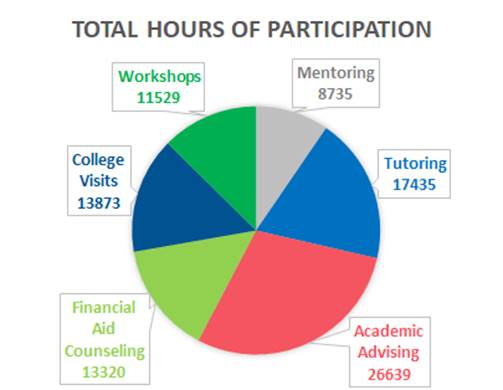
Observations and Plans for the year ahead
The 2018 Academic Year was a momentous one for the University System of Georgia. Meeting the ambitious goal of fully implementing the Momentum Year for all students at all institutions demanded unprecedented coordination and alignment of System and campus resources. The substantial accomplishments of 2018-2019 – including fully scaling CoRequisite Learning Support for all students, aligning programs of study into academic focus areas, establishing program maps for all programs, creating new advising and transition models, deploying academic mindset interventions in courses, and much more – were the results of tremendous commitments from institutions to rethink and realign their work. The meetings held by the System Office in support of the Momentum Year were structured to provide institutional teams the opportunity to explore the ideas and data behind the pillars of the approach, develop an understanding of how they can be adapted to local context, and create a concrete plan for implementation. This has resulted in a more structured and consistent approach across the System and has provided opportunities for institutions in all sectors and degrees of capacity to engage in the Momentum Approach in a way that is ambitious but grounded in a realistic understanding of how the work will be done.
This year continued the broader integration of units from across institutions in student success work and a further commitment to communicate the Momentum framework deeper into the institution. Historically, student success has been largely viewed from within institutions as the domain of academic affairs. Making good on a promise to expand the audience for Momentum, the 2019 Momentum Summit convened 500 deans, chairs, professional staff, and cabinet-level leadership convening to reflect on how purpose, pathways, and mindset and develop individual and institutional plans for integrating their insights to improve the student experience. By capitalizing on the remarkable opportunity to draw upon the breadth of experience that exists among faculty, staff and administrators in a system the size of Georgia’s, the CCG team amplified and accelerated the development of concrete practices that reflect the Momentum principles in an unprecedented manner.
Understanding the importance of supporting institutions on their home turf and seeing the context in which the work takes place, CCG staff conducted site visits to consult with staff and faculty and observe activities on more than half of all institutions this year, including multiple site visits to provide technical assistance and guidance on the development and implementation of plans related to the Momentum Year and transition to college. This more direct approach provides an opportunity for the System to understand the work of our institutions and for institutions to have more structured inquiry around their student success work.
In the year ahead, the CCG team will be working on deepening the understanding of the Momentum Approach, most especially with faculty and front-line staff who are the most immediate and frequent points of contact for students, and to understand how the Momentum framework applies across the breadth of the institution and the length of the student’s academic career and beyond. This will take place against the backdrop of redesigning the core curriculum and new opportunities to shape and understand student mindsets.
Additionally, the System will continue to support institutions in their work on deepening learning for students both in their gateway courses and across their academic careers, and will refine and reinforce the work of supporting students as they make their transition to college. Importantly, in Fall 2019, all students will be enrolled in a program of study or academic focus area prior to starting classes. Institutions will provide infrastructure and procedures on campuses to ensure that students are informed of their academic choice and its career connections, can discern their fit for the program and the field, and affirm their choice through course taking and co-curricular engagement. Complete College Georgia will provide support on all levels of implementation, with a particular focus in 2019 on front line faculty and staff.

